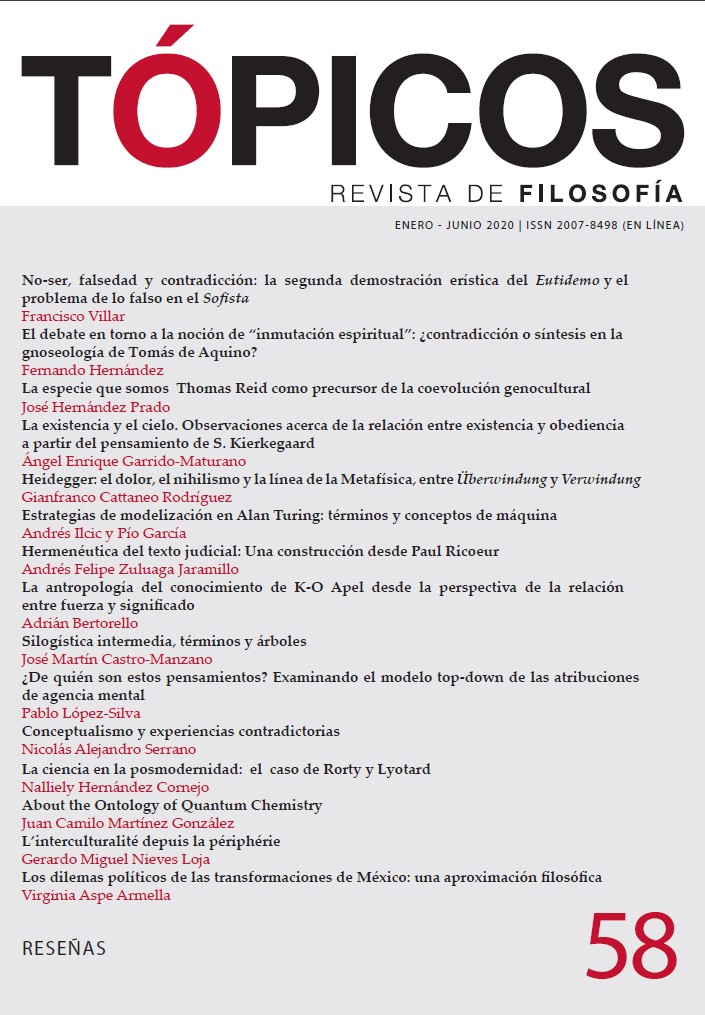Publicado 2019-12-13
Palabras clave
Cómo citar
Castro-Manzano, J. M. . (2019). Silogística intermedia, términos y árboles. Tópicos, Revista De Filosofía, (58), 209–237. https://doi.org/10.21555/top.v0i58.1065
Descargas
Los datos de descargas todavía no están disponibles.
Altmetrics
Citas
Resumen
En este trabajo proponemos un método de árboles para la silogística intermedia de Peterson y Thompson usando el álgebra de Sommers y Englebretsen. El resultado es un método analítico de
árboles capaz de modelar inferencia en silogística básica, relacional e intermedia.
Citas
- Castro-Manzano, J. M. (2018). A Tableaux Method for Term Logic. LANMR 2018, 2264, 1-14.
- Castro-Manzano, J. M. (2019). An Intermediate Term Functor Logic. Argumentos, Revista de Filosofía, 11(22), 17-31.
- Castro-Manzano, J. M., Lozano-Cobos, L. I. y Reyes-Cárdenas, P. O. (2018). Programming with Term Logic. BRAIN. Broad Research in Artificial Intelligence and Neuroscience, 9(3), 22-36.
- Castro-Manzano, J. M. y Pacheco-Montes, J. R. (2018). Moded Diagrams for Moded Syllogisms. En P. Chapman, G. Stapleton, A. Moktefi, S. Perez-Kriz y F. Bellucci (eds.), Diagrammatic Representation and Inference. Diagrams 2018. (pp. 757-760). Lecture Notes in Computer Science, vol. 10871. Cham: Springer.
- Carnap, R. (1930). Die alte und die neue Logik. Erkenntnis, 1, 12-26.
- D’Agostino, M., Gabbay, D. M., Hähnle, R. y Posegga, J. (1999). Handbook of Tableau Methods, Heidelberg: Springer.
- Englebretsen, G. (1987). The New Syllogistic. Nueva York-Berna: Peter Lang.
- Englebretsen, G. (1988). Preliminary Notes on a New Modal Syllogistic. Notre Dame Journal of Formal Logic, 29(3), 381-395.
- Englebretsen, G. (1991). Linear Diagrams for Syllogisms (with Relationals). Notre Dame Journal of Formal Logic, 33(1), 37-69.
- Englebretsen, G. (1996). Something to Reckon with: The Logic of Terms. Ottawa: University of Ottawa Press.
- Englebretsen, G. y Sayward, C. (2011). Philosophical Logic: An Introduction to Advanced Topics. Londres: Bloomsbury Academic.
- Geach, P. (1962). Reference and Generality: An Examination of Some Medieval and Modern Theories. Ithaca: Cornell University Press.
- Geach, P. (1980). Logic Matters. Oakland: University of California Press.
- Keil, F. (2005). Exploring Boundary Conditions on the Structure of Knowledge: Some Nonobvious Influences of Philosophy on Psychology. En David S. Oderberg (ed.), The Old New Logic: Essays on the Philosophy of Fred Sommers. (pp. 67-84). Londres: Bradford.
- Khemlani, S. y Johnson-Laird, P. N. (2012). Theories of the Syllogism: A Meta-Analysis. Psychological Bulletin, 427-457.
- Kuhn, S. (1983). An Axiomatization of Predicate Functor Logic. Notre Dame Journal of Formal Logic, 24(2), 233-241.
- Malink, M. (2006). A Reconstruction of Aristotle’s Modal Syllogistic. History and Philosophy of Logic, 27, 95-141.
- Moss, L. (2015). Natural Logic. En S. Lappin y C. Fox (eds.), The Handbook of Contemporary Semantic Theory. (pp. 559-592). Hoboken: John Wiley & Sons.
- Mozes, E. (1989). A Deductive Database Based on Aristotelian Logic. Journal of Symbolic Computation, 7(5), 487-507.
- Murphree, W. (1998). Numerical Term Logic. Notre Dame Journal of Formal Logic, 39(3), 346-362.
- Noah, A. (1980). Predicate-functors and the Limits of Decidability in Logic. Notre Dame Journal of Formal Logic, 21(4), 701-707.
- Noah, A. (2005). Sommers’s Cancellation Technique and the Method of Resolution. En David S. Oderberg (ed.), The Old New Logic: Essays on the Philosophy of Fred Sommers. (pp. 169- 182). Londres: Bradford.
- Peterson, P. L. (1979). On the Logic of “few”, “many”, and “most”. Notre Dame Journal of Formal Logic, 20, 155-179.
- Priest, G. (2008). An Introduction to Non-Classical Logic: From If to Is. Cambridge: Cambridge University Press.
- Quine, W. V. O. (1971). Predicate Functor Logic. En J. E. Fenstad (ed.), Proceedings of the Second Scandinavian Logic Symposium. (pp. 309-316). Ámsterdam: North-Holland.
- Rini, A. A. (1998). Is There a Modal Syllogistic? Notre Dame Journal of Formal Logic, 39(4), 554-572.
- Russell, B. (1937). A Critical Exposition of the Philosophy of Leibniz: With an Appendix of Leading Passages. Londres: G. Allen & Unwin.
- Sommers, F. (1967). On a Fregean Dogma. En I. Lakatos (ed.), Problems in the Philosophy of Mathematics. (pp. 47- 81). Studies in Logic and the Foundations of Mathematics, vol. 47. Ámsterdam: Elsevier.
- Sommers, F. (1982). The Logic of Natural Language. Oxford: Oxford University Press.
- Sommers, F. (2005). Intellectual Autobiography. En David S. Oderberg (ed.), The Old New Logic: Essays on the Philosophy of Fred Sommers. (pp. 1-24). Londres: Bradford.
- Sommers, F. y Englebretsen, G. (2000). An Invitation to Formal Reasoning: The Logic of Terms. Farnham: Ashgate.
- Staal, J. F. (1969). Formal Logic and Natural Languages (a Symposium). Foundations of Language, 5(2), 256-284.
- Thom, P. (1996). The Logic of Essentialism. An Interpretation of Aristotle’s Modal Syllogistic. Dordrecht: Kluwer.
- Thompson, B. (1982). Syllogisms using “few”, “many”, and “most”. Notre Dame Journal of Formal Logic, 23(1), 75-84.
- Thompson, B. (1986). Syllogisms with Statistical Quantifiers. Notre Dame Journal of Formal Logic, 27(1), 93-103.
- Veatch, H. B. (1970). Intentional Logic: A Logic Based on Philosophical Realism. Hamden: Archon Books.






